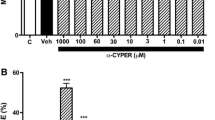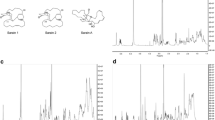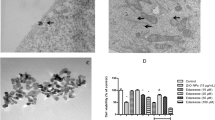Abstract
The precise mechanism underlying the role of nitric oxide (NO) or nitric oxide synthases (NOSs) in paraquat-mediated toxicity is yet to be fully elucidated. The importance of the NADPH-diaphorase activity of NOSs in paraquat toxicity, in addition to the production of NO, has previously been reported as a mechanism of toxicity. However, other studies have highlighted the toxicity of NO alone and, conversely a protective role of NO in paraquat-mediated toxicity has also been described. The goal of this study was to clarify the involvement of NO and NOS in paraquat-mediated toxicity in an SH-SY5Y cell system, and to evaluate the putative role of 7-nitroindazole as a protective agent in human neural cells. Our results indicate that the three previously described isoforms of NOS are expressed in SH-SY5Y cells, with the data showing that these synthases act as paraquat diaphorases. While this process could occur at the expense of NO production, NO alone does play a toxic role, with its production leading to the formation of the toxicant peroxynitrite. Although the efficacies of the different inhibitors tested cannot be directly compared because the various NOS forms were probably inhibited to differing extents, the results support the idea that endogenous and inducible NO is a neurotoxic mediator of the effects of paraquat. The NADPH-diaphorase activity of NOS and NO production are therefore factors implicated in the toxicity mediated by the herbicide paraquat.













Similar content being viewed by others
References
Amoroso S, Gioielli A, Cataldi M, Di Renzo G, Annunziato L (1999) In the neuronal cell line SH-SY5Y, oxidative stress-induced free radical overproduction causes cell death without any participation of intracellular Ca(2+) increase. Biochim Biophys Acta 11:151–160
Bengmark S (2006) Curcumin, an atoxic antioxidant and natural NFkappaB, cyclooxygenase-2, lipooxygenase, and inducible nitric oxide synthase inhibitor: a shield against acute and chronic diseases. JPEN J Parenter Enteral Nutr 30:45–51
Berisha H, Pakbaz H, Absood A, Foda HD, Said SI (1994a) Nitric oxide mediates oxidant tissue injury caused by paraquat and xanthine oxidase. Ann N Y Acad Sci 723:422–425
Berisha HI, Pakbaz H, Absood A, Said SI (1994b) Nitric oxide as a mediator of oxidant lung injury due to paraquat. Proc Natl Acad Sci USA 91:7445–7449
Bonneh-Barkay D, Reaney SH, Langston WJ, Di Monte DA (2005a) Redox cycling of the herbicide paraquat in microglial cultures. Brain Res Mol Brain Res 134:52–56
Bonneh-Barkay D, Langston WJ, Di Monte DA (2005b) Toxicity of redox cycling pesticides in primary mesencephalic cultures. Antioxid Redox Signal 7:649–653
Cho JH, Yang DK, Kim L, Ryu JS, Lee HL, Lim CM, Koh YS (2005) Inhaled nitric oxide improves the survival of the paraquat-injured rats. Vascul Pharmacol 42:171–178
Coutts AS, La Thangue NB (2005) The p53 response: emerging levels of co-factor complexity. Biochem Biophys Res Commun 10:778–785
Davis KL, Martin E, Turko IV, Murad F (2001) Novel effects of nitric oxide. Annu Rev Pharmacol Toxicol 41:203–236
Dawson TM, Bredt DS, Fotuhi M, Hwang PM, Snyder SH (1991) Nitric oxide synthase and neuronal NADPH diaphorase are identical in brain and peripheral tissues. Proc Natl Acad Sci USA 88:7797–7801
Day BJ, Patel M, Calavetta L, Chang LY, Stamler JS (1999) A mechanism of paraquat toxicity involving nitric oxide synthase. Proc Natl Acad Sci USA 96:12760–12765
Djukic M, Jovanovic MC, Ninkovic M, Vasiljevic I, Jovanovic M (2007) The role of nitric oxide in paraquat-induced oxidative stress in rat striatum. Ann Agric Environ Med 14:247–252
Drysdale BE, Zacharchuk CM, Shin HS (1983) Mechanism of macrophage-mediated cytotoxicity: production of a soluble cytotoxic factor. J Immunol 131:2362–2367
Ebadi M, Sharma SK (2003) Peroxynitrite and mitochondrial dysfunction in the pathogenesis of Parkinson’s disease. Antioxid Redox Signal 5:319–335
Fuentes JM, Lompré AM, Møller JV, Falson P, le Maire M (2000) Clean Western blots of membrane proteins after yeast heterologous expression following a shortened version of the method of Perini et al. Anal Biochem 285(2):276–278
Gonzalez-Polo RA, Boya P, Pauleau AL, Jalil A, Larochette N, Souquere S, Eskelinen EL, Pierron G, Saftig P, Kroemer G (2005) The apoptosis/autophagy paradox: autophagic vacuolization before apoptotic death. J Cell Sci 118:3091–3102
Gonzalez-Polo RA, Niso-Santano M, Ortiz-Ortiz MA, Gomez-Martin A, Moran JM, Garcia-Rubio L, Francisco-Morcillo J, Zaragoza C, Soler G, Fuentes JM (2007) Inhibition of paraquat-induced autophagy accelerates the apoptotic cell death in neuroblastoma SH-SY5Y cells. Toxicol Sci 97:448–458
Groc L, Jackson HT, Jiang H, Bezin L, Koubi D, Corcoran GB, Levine RA (2002) Nitric oxide synthase inhibition during development: effect on apoptotic death of dopamine neurons. Brain Res Dev Brain Res 138:147–153
Hansen MB, Nielsen SE, Berg K (1989) Re-examination and further development of a precise and rapid dye method for measuring cell growth/cell kill. J Immunol Methods 119:203–210
Hobbs AJ, Higgs A, Moncada S (1999) Inhibition of nitric oxide synthase as a potential therapeutic target. Annu Rev Pharmacol Toxicol 39:191–220
Hope BT, Michael GJ, Knigge KM, Vincent SR (1991) Neuronal NADPH diaphorase is a nitric oxide synthase. Proc Natl Acad Sci USA 88:2811–2814
Jung KK, Lee HS, Cho JY, Shin WC, Rhee MH, Kim TG, Kang JH, Kim SH, Hong S, Kang SY (2006) Inhibitory effect of curcumin on nitric oxide production from lipopolysaccharide-activated primary microglia. Life Sci 19:2022–2031
Kalisch BE, Jhamandas K, Beninger RJ, Boegman RJ (1999) Modulation of quinolinic acid-induced depletion of striatal NADPH diaphorase and enkephalinergic neurons by inhibition of nitric oxide synthase. Brain Res 817:151–162
Kirkeby S, Thomsen CE (2005) Quantitative immunohistochemistry of fluorescence labelled probes using low-cost software. J Immunol Methods 301:102–113
Kojima H, Urano Y, Kikuchi K, Higuchi T, Hirata Y, Nagano T (1999) Fluorescent indicators for imaging nitric oxide production. Angew Chem Int Ed Engl 38:3209–3212
Koppel C, von Wissmann C, Barckow D, Rossaint R, Falke K, Stoltenburg-Didinger G, Schnoy N (1994) Inhaled nitric oxide in advanced paraquat intoxication. J Toxicol Clin Toxicol 32:205–214
MacKenzie GM, Jenner P, Marsden CD (1995) Effect of 7-nitroindazole on quinolinic acid-induced striatal toxicity in the rat. Neuroreport 6:1789–1794
Marletta MA (1994) Nitric oxide synthase: aspects concerning structure and catalysis. Cell 78:927–930
Maruyama K, Takeuchi M, Chikusa H, Muneyuki M (1995) Reduction of intrapulmonary shunt by low-dose inhaled nitric oxide in a patient with late-stage respiratory distress associated with paraquat poisoning. Intensive Care Med 21:778–779
Moncada S (1997) Nitric oxide in the vasculature: physiology and pathophysiology. Ann N Y Acad Sci 811:60–67
Mosmann T (1983) Rapid colorimetric assay for cellular growth and survival: application to proliferation and cytotoxicity assays. J Immunol Methods 65:55–63
Palmer RM, Ferrige AG, Moncada S (1987) Nitric oxide release accounts for the biological activity of endothelium-derived relaxing factor. Nature 327:524–526
Pou S, Pou WS, Bredt DS, Snyder SH, Rosen GM (1992) Generation of superoxide by purified brain nitric oxide synthase. J Biol Chem 267:24173–24176
Schmidt HH, Pollock JS, Nakane M, Forstermann U, Murad F (1992a) Ca2+/calmodulin-regulated nitric oxide synthases. Cell Calcium 13:427–434
Schmidt HH, Gagne GD, Nakane M, Pollock JS, Miller MF, Murad F (1992b) Mapping of neural nitric oxide synthase in the rat suggests frequent co-localization with NADPH diaphorase but not with soluble guanylyl cyclase, and novel paraneural functions for nitrinergic signal transduction. J Histochem Cytochem 40:1439–1456
Shimizu K, Matsubara K, Ohtaki K, Shiono H (2003a) Paraquat leads to dopaminergic neural vulnerability in organotypic midbrain culture. Neurosci Res 46:523–532
Shimizu K, Matsubara K, Ohtaki K, Fujimaru S, Saito O, Shiono H (2003b) Paraquat induces long-lasting dopamine overflow through the excitotoxic pathway in the striatum of freely moving rats. Brain Res 976:243–252
Valtschanoff JG, Weinberg RJ, Kharazia VN, Schmidt HH, Nakane M, Rustioni A (1993) Neurons in rat cerebral cortex that synthesize nitric oxide: NADPH diaphorase histochemistry, NOS immunocytochemistry, and colocalization with GABA. Neurosci Lett 157:157–161
Wallace MN, Bisland SK (1994) NADPH-diaphorase activity in activated astrocytes represents inducible nitric oxide synthase. Neuroscience 59:905–919
Zhan Q (2005) Gadd45a, a p53- and BRCA1-regulated stress protein, in cellular response to DNA damage. Mutat Res 6:133–143
Acknowledgments
Supported by grants PR06B124 and GRU08019 from the Junta de Extremadura, Spain, and PI070400 (Fondo de Investigación Sanitaria, Ministerio de Sanidad y Consumo, Spain). J.M.M. was supported by a postdoctoral fellowship from CIBERNED, M.A.O. and J.M.B.S.P were supported by Junta of Extremadura predoctoral fellowships, R.A.G.P. was supported by a Juan de la Cierva (Ministerio de Ciencia e Innovación) re-incorporation fellowship and M.N.S. was supported by a predoctoral fellowship from CIBERNED. The authors would like to thank P. Delgado for technical assistance, FUNDESALUD, Dr. Francisco Javier Morcillo (Departamento de Biología Celular, Universidad de Extremadura, Spain) for his assistance with the NADPH-diaphorase activity method and Dr. J.A. Rosado (Departamento de Fisiología, Universidad de Extremadura, Spain) for his assistance with BAPTA assay.
Author information
Authors and Affiliations
Corresponding authors
Additional information
Miguel A. Ortiz-Ortiz and José M. Morán have contributed equally to this work.
Rights and permissions
About this article
Cite this article
Ortiz-Ortiz, M.A., Morán, J.M., González-Polo, R.A. et al. Nitric Oxide-Mediated Toxicity in Paraquat-Exposed SH-SY5Y Cells: A Protective Role of 7-Nitroindazole. Neurotox Res 16, 160–173 (2009). https://doi.org/10.1007/s12640-009-9065-6
Received:
Revised:
Accepted:
Published:
Issue Date:
DOI: https://doi.org/10.1007/s12640-009-9065-6




